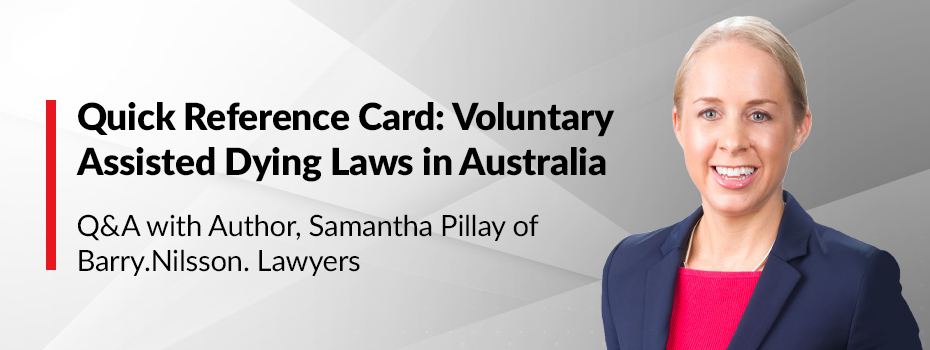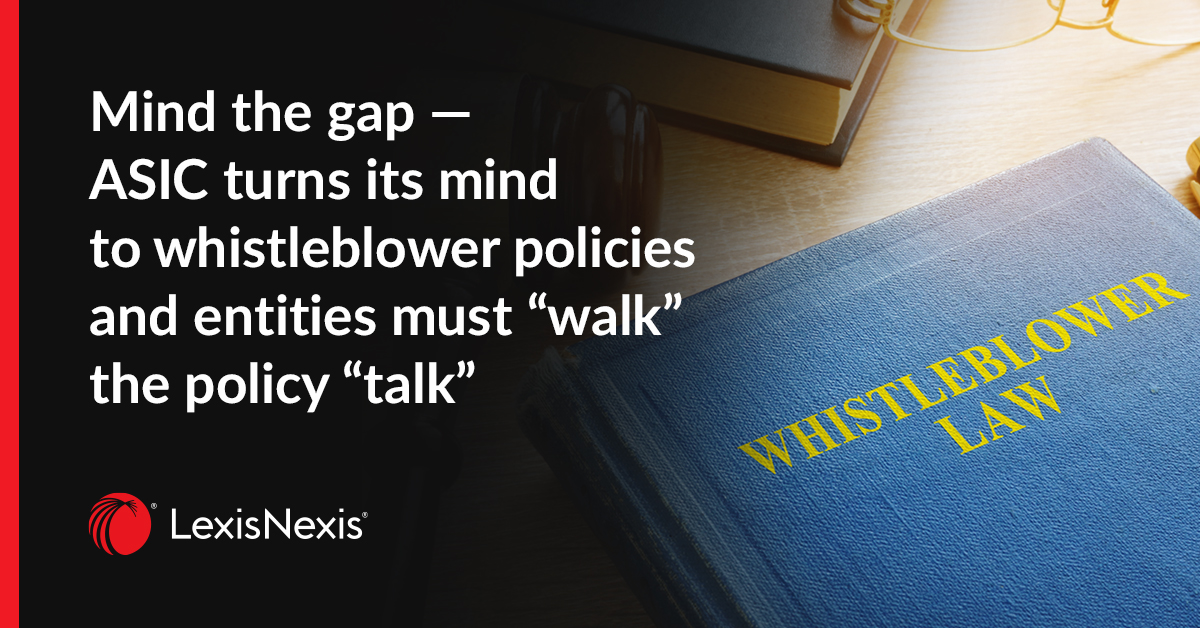
Quick Reference Card: Voluntary Assisted Dying Laws in Australia Q&A with author, Samantha Pillay of Barry Nilsson Lawyers
27 October 2022 02:20
Voluntary assisted dying (VAD) legislation has now been passed in all Australian states. This legislation provides a legal process for health practitioners to assist a terminally-ill person to end their life in limited circumstances, and subject to completing a prescribed process.
We spoke with Samantha Pillay of Barry.Nilsson. Lawyers about her recently released Quick Reference Card: Voluntary Assisted Dying Laws in Australia.
The QRC provides an excellent starting point for research in this area with a detailed comparison of how the state laws differ in their operation – what surprised you the most about this when putting the text together?
I was surprised by the different ways of expressing the same concepts and by the fact that each piece of legislation has subtle differences in wording. Creating a concise reference tool in this context was a significant undertaking, but worthwhile I think as it will certainly save time.
There were also some surprising differences between states. For example, Queensland is the only state in which it will be an offence to ‘dishonestly or by coercion’ induce someone to revoke a VAD request. The offence is punishable by seven years imprisonment, with the Queensland Law Reform Commission commenting that this is intended to reflect the seriousness of the offence. It is hard to predict what enforcement will look like, and we can’t look to Victoria for an indication as the offence does not exist there.
Did you come across any major challenges when putting this together?
During the drafting process the New South Wales bill was still being considered by parliament, so we could only speculate about what would happen here. It was towards the end of the writing process that the bill was passed. With additional research we were able to include commentary on the New South Wales regime, which means the Quick Reference Card reflects VAD laws in all Australian states. Particular thanks must go to our research guru, Margeaux Dillon, for her tireless work in assisting with this and other aspects.
The laws governing VAD in Australia are all very new, with Victoria passing laws in 2017, and NSW being the last state to legalise the practice in May this year. Where do you see this area of law developing most in the next 5 years?
It will be interesting to see how professional regulation and guidelines develop in response to some of the issues that arise in this area.
For example, the medical profession has already raised the difficulty with assessing the prognosis eligibility criterion: how do we know whether someone has 6 or 12 months to live, and how certain do we need to be? Prognostication is an inexact science, and this may be magnified by the fact that the legislation uses different wording in different states. In Western Australia and New South Wales, VAD is only available for conditions that ‘will, on the balance of probabilities, cause death within a period of six months’, while in Queensland, the condition must be ‘expected to cause death within 12 months’. Assessing this aspect requires an element of judgment, as can the repeated assessment of capacity in conditions which cause cognitive decline. Clinicians may be exposed to criticism for perceived bias toward a particular outcome, or for ‘stretching the rules’ to favour access for particular patients.
From a legislative perspective, we will be ‘watching this space’ in relation to the ACT and Northern Territory given the momentum that has been generated by those states in recent months, as well as the Restoring Territory Rights Bill recently introduced to parliament. We are also interested to see what comes of the calls for amendment to the Commonwealth criminal law in relation to the carriage services offence. VAD implementation in Queensland and Western Australia – states with significant regional and remote populations – may result in an increase in advocacy for the ability to use telehealth for VAD consultations to make access more equitable.
Why should practitioners buy the QRC?
For a long time, debates about access to assisted dying in Australia were really confined to purely academic speculation and practical ethics. It is only now, with all states legalising the practice, that we have a solid foundation for these discussions. The QRC provides practitioners with a comprehensive overview of how these laws operate, which saves time and money when it comes to legal research.
I think this QRC will be particularly handy for those practitioners who are required to advise across multiple Australian states, including MDOs or general counsel in national healthcare organisations. With each state having its own unique legal framework, there is too much information for someone to keep in their head. Having a go-to resource to reach for when answering questions from around the country will be invaluable.
For more information, contact your relationship manager or visit our eStore.
ABOUT THE AUTHOR
Samantha Pillay is a Principal in the Insurance and Health team at Barry.Nilsson. Lawyers, Brisbane. Sam advises and represents clients across the healthcare system including in litigation, regulatory and coronial processes. Her professional interests include emergency treatment and healthcare for children. Sam is a member of the editorial board of the Australian Health Law Bulletin and has appeared on the ABC’s Law Report program providing legal commentary about the withdrawal of life sustaining treatment.
Latest Articles
-
 3 tips for banking and finance lawyers when responding to an ASIC enquiry, and how to avoid misleading or deceptive conduct.
3 tips for banking and finance lawyers when responding to an ASIC enquiry, and how to avoid misleading or deceptive conduct. -
 Significant increases to competition and consumer law penalties have commenced and sweeping reforms to the unfair contract terms regime will follow in 12 months’ time.
Significant increases to competition and consumer law penalties have commenced and sweeping reforms to the unfair contract terms regime will follow in 12 months’ time. -
 The Australian Securities and Investments Commission (ASIC) is calling on Australian CEOs, from public companies, large proprietary companies and corporate superannuation trustees to review their whistleblower policies and processes to ensure compliance with private sector whistleblower laws.
The Australian Securities and Investments Commission (ASIC) is calling on Australian CEOs, from public companies, large proprietary companies and corporate superannuation trustees to review their whistleblower policies and processes to ensure compliance with private sector whistleblower laws.
Practical Guidance
Your one-stop solution for accurate legal answers from Australian legal experts. Tools, practically focused guidance notes, checklists, precedents, and training materials support and streamline your legal workflow.
LEARN MORE LexisNexis
LexisNexis